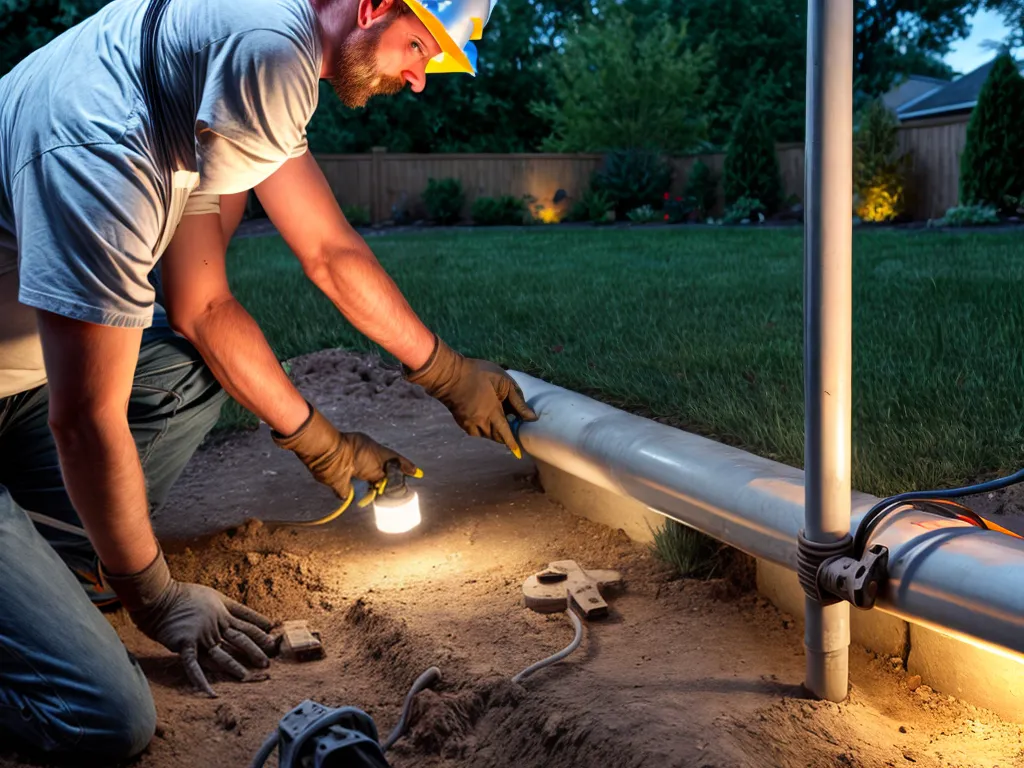
Installing underground electrical lines for outdoor lighting can seem daunting, but with proper planning and safety precautions, it can be done safely by a homeowner. Here is a step-by-step guide to help you successfully install underground electrical lines to power outdoor lighting fixtures.
Researching Electrical Code Requirements
The first step is to research your local electrical code requirements. Electrical codes provide important safety guidelines and determine how deep your electrical lines must be buried.
Key things to research in your local electrical code:
- Minimum burial depth for underground electrical wiring
- Type of conduit required i.e. PVC, metal etc.
- Wiring and circuit specifications
- Any permits required for outdoor electrical work
Thorough research of the code requirements will ensure your installation meets all safety standards. I researched my local electrical code and determined a 12 inch burial depth and PVC conduit was required.
Planning the Electrical Layout
Next, plan the layout of the underground electrical lines.
Important factors to consider for your layout:
- Where the power source will be located
- Where each lighting fixture will be placed in your outdoor space
- Any obstructions like trees, structures, pathways etc.
- The easiest routes to run the underground lines between the power source and lighting fixtures
I sketched a rough layout showing the house power source, the 10 yard lights I was installing around my deck, and the routes for the underground lines. Planning it out on paper first made it easier to visualize the full scope of the project.
Gathering the Right Materials
There are several key materials needed to complete the installation:
- Outdoor rated electrical wiring - this wiring is thicker with weatherproof insulation
- Conduit piping - PVC is commonly used to encase and protect wiring
- Junction boxes - for connecting wires and branching the circuit
- Trenching shovel or excavator - to dig trenches for buried lines
- Outdoor lighting fixtures
- GFCI outlet - for connecting the power source
I made a complete list of all materials and hardware I would need based on my plan. Having everything ready ahead of time ensured I could efficiently install the electrical system.
Digging the Trenches
Now it's time to start digging. Outline the paths for your planned buried lines and use a trenching shovel or excavator to dig trenches 12-18 inches deep.
Key tips for digging trenches safely:
- Call 811 before digging to have any utility lines marked
- Wear protective eyewear and gloves
- Make sure trenches have a proper slope for drainage
- Shore up deeper trenches with supports to prevent cave-ins
I called 811, then used a rental excavator to dig my trenches 12 inches deep along the paths I had outlined. I made sure to call in advance and schedule my equipment rental.
Installing the Conduit
The conduit piping encases and protects the electrical wiring underground.
To install conduit properly:
- Measure lengths of conduit needed between boxes/fixtures
- Cut conduit to appropriate lengths
- Connect conduit together with fittings like elbows or T-shapes as needed
- Lay conduit in trench and join all pieces until path is complete
I used PVC cement to glue all the conduit connections securely. This creates a continuous enclosed path for pulling the wires.
Running the Wiring Through the Conduit
Now you're ready to run the outdoor-rated electrical wires through the conduit.
Helpful tips for wiring:
- Leave 12-18 inches of extra wire at all boxes and endpoints
- Carefully pull wires to avoid damage to insulation
- Use wire lubricant to ease wire pulling if needed
- Attach wires to junction box endpoints using clamps
I used a fish tape to easily pull the wiring through the entire underground conduit system. Leaving slack at the endpoints gave me plenty of room to work.
Connecting the Wiring to Fixtures and Power Source
The final step is to connect the buried wiring to your lighting fixtures, power source, and any switches or control boxes.
- Follow all local codes for outdoor electrical junction boxes and GFCI receptacles
- Make splices safely using appropriate connectors
- Attach fixture wiring using silicone filled wire nuts for water protection
- Test lights to confirm all connections are solid
I connected my lighting fixtures to the emerge wires using silicone wire nuts. I used an outdoor GFCI outlet with an in-use cover to connect the power source from my house.
Closing Up and Finishing Touches
Once all electrical connections are made and tested, you can close up the trenches and complete the finished look.
- Fill in trenches with soil and compact it down firmly
- Consider burying PVC piping with pull strings for any future wiring expansion
- Install covers and stakes to protect any vulnerable conduit areas
- Run wiring to switches and control boxes if using automated lighting
After backfilling the trenches, I stapled the conduit piping to secure it and provide protection. Then I tested all the lighting fixtures and dimmer controls. My underground lighting installation was complete!
Installing underground electrical lines is manageable if local codes are followed using proper materials and safety precautions. Proper planning of the layout and wiring system is also key to a successful installation. With patience and attention to detail, you can have professional quality outdoor lighting powered by a concealed underground electrical system.